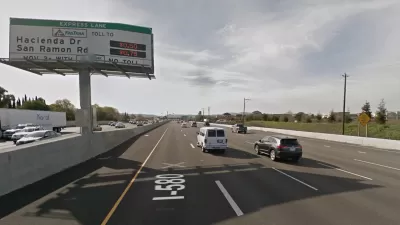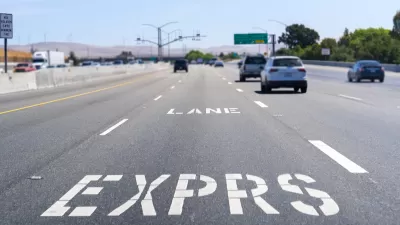Due to the high level of existing congestion, the Metropolitan Transportation Commission warns motorists that the new I-680 Contra Costa Express Lanes will offer relief just before and after the peak commute hour.
Michael Cabanatuan of the San Francisco Chronicle reports on the new high occupancy toll (HOT) lanes through the San Ramon Valley in Contra Costa County, the first express lanes to be constructed and operated by the Bay Area's metropolitan planning organization, the Metropolitan Transportation Commission (MTC).
“This is not going to eliminate congestion in the 680 corridor,” said John Goodwin of MTC. “Absolutely expect it to relieve congestion, especially ... just before and after peak travel times. But during periods of consistently very heavy traffic, during the peak, the express lanes may not move the needle a great deal."
If traffic is so heavy that the express lanes come to a slow crawl, only carpools will be allowed into the lane until the flow improves.
The lanes, converted from existing carpool lanes, stretch 11-12 miles in each direction, and will operate as express (or HOT) lanes from 5 a.m.-8 p.m., Monday through Friday, unlike Northern Virginia's I-66 lanes which will open in December as "the first rush-hour-only, peak-period toll system of its kind in the United States," as noted here on Tuesday.
Carpools, clean air vehicles, and motorcycles continue to get break
Unlike the I-66 HOT lanes, though, "clean air vehicles" will continue to use the converted high occupancy vehicle (HOV) lanes toll-free provided they have the white or green decals and a FasTrak Flex toll transponder set in the 3+ position. Carpools also will continue to operate toll-free provided they have the flex toll transponder set in either the 2 or 3+ position. Motorcycles need the flex transponder as well.
Congestion pricing will apply, with a minimum of $.50 for each of the two sections of the roadway. A maximum toll has not been set.
Network is growing
"With the addition of the 680 Contra Costa lanes, the Bay Area’s express lanes now cover 75 miles," adds Cabanatuan for The Chronicle. While these are the first lanes to be built and operated by the Bay Area Infrastructure Financing Authority, a joint powers authority between MTC and the Bay Area Toll Authority, other Bay Area express lanes fall under the authorities of the Santa Clara Valley Transportation Authority and the Alameda County Transportation Commission.
By 2035, regional transportation planners expect them to form a network that stretches 550 miles mostly in the East Bay and South Bay.
Coming next, in 2020, are express lanes on Interstate 880 between the southern tip of Oakland and Highway 237 in Milpitas and an extension of the Contra Costa lanes in the southbound direction to Marina Vista in Martinez [click on "Martinez to Walnut Creek" near the bottom of page].
Both of these projects are spearheaded by MTC. Click here for a map of the entire 550-mile Bay Area Express Lane network, with links to details for each corridor.
For more details on the I-680 Contra Costa Express Lanes, click on 511.org/driving/express-lanes/work.
Hat tip: AASHTO Daily Transportation Update.
FULL STORY: Express lanes to help ease congestion in 680 corridor

Study: Maui’s Plan to Convert Vacation Rentals to Long-Term Housing Could Cause Nearly $1 Billion Economic Loss
The plan would reduce visitor accommodation by 25,% resulting in 1,900 jobs lost.

North Texas Transit Leaders Tout Benefits of TOD for Growing Region
At a summit focused on transit-oriented development, policymakers discussed how North Texas’ expanded light rail system can serve as a tool for economic growth.

Using Old Oil and Gas Wells for Green Energy Storage
Penn State researchers have found that repurposing abandoned oil and gas wells for geothermal-assisted compressed-air energy storage can boost efficiency, reduce environmental risks, and support clean energy and job transitions.

Private Donations Propel Early Restoration of Palisades Playground
Los Angeles has secured over $1.3 million in private funding to restore the Pacific Palisades playground months ahead of schedule, creating a modern, accessible space that supports community healing after recent wildfires.

From Blight to Benefit: Early Results From California’s Equitable Cleanup Program
The Equitable Community Revitalization Grant (ECRG) program is reshaping brownfield redevelopment by prioritizing projects in low-income and environmental justice communities, emphasizing equity, transparency, and community benefits.

Planting Relief: Tackling Las Vegas Heat One Tree at a Time
Nevada Plants, a Las Vegas-based nonprofit, is combating the city’s extreme urban heat by giving away trees to residents in underserved neighborhoods, promoting shade, sustainability, and community health.
Urban Design for Planners 1: Software Tools
This six-course series explores essential urban design concepts using open source software and equips planners with the tools they need to participate fully in the urban design process.
Planning for Universal Design
Learn the tools for implementing Universal Design in planning regulations.
Ascent Environmental
Borough of Carlisle
Institute for Housing and Urban Development Studies (IHS)
City of Grandview
Harvard GSD Executive Education
Toledo-Lucas County Plan Commissions
Salt Lake City
NYU Wagner Graduate School of Public Service




























